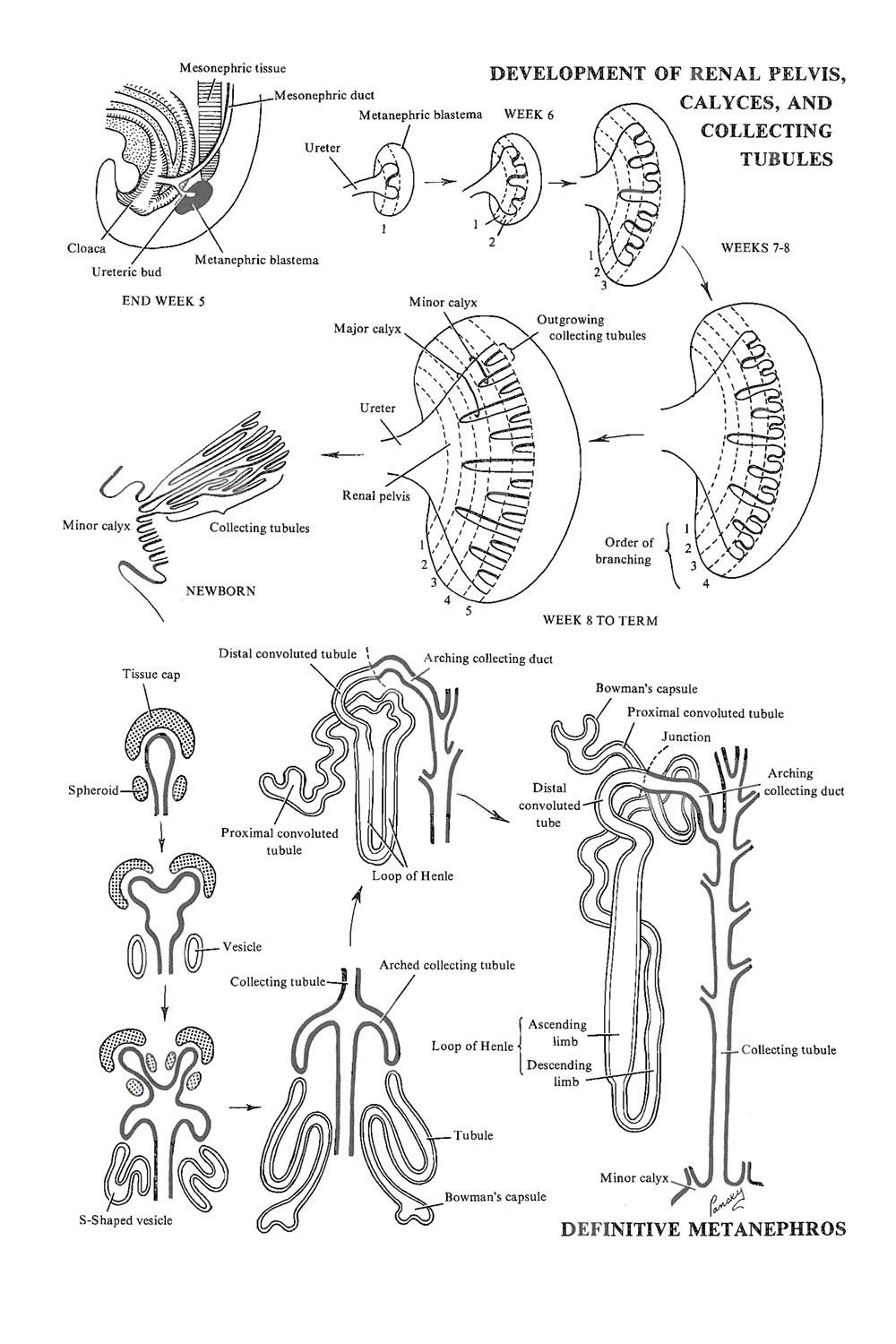93. The Urinary or Excretory System: The Metanephros
Review of MEDICAL EMBRYOLOGY Book by BEN PANSKY, Ph.D, M.D.
- The metanephros (hind kidney) or permanent kidney: the metanephric blastema, a nonsegmented homogenous mesodermal mass, enters its active phase of differentiation at the beginning of month 2 (week 5) and begins to function about 3 weeks later
- URINE FORMATION continues actively throughout the fetal life
- Urine combines with amniotic fluid, which the fetus drinks, and is absorbed by the intestin The fetal kidneys regulate amniotic volume, and if the kidneys are absent, amniotic fluid volume is abnormally small (oligohydramnios)
- THERE IS NO VITAL NEED FOR PRENATAL FUNCTION of the kidneys because metabolic wastes are transferred via the placenta to the mother, but the fetus would die perinatally without the kidneys
- Metanephric differentiation begins when the metanephric blastema (mass of mesoderm) is penetrated by the ureteric bud (metanephric diverticulum) which arises from the lower portion of the mesonephric (wolffian) duct
- THE URETERIC BUD arises as a dorsal bud, at the beginning of month 2, from the lower end of the mesonephric duct, and rapidly reaches and penetrates the metanephric blastema which, in turn, forms a "cap" over the bud
- The bud then enlarges and forms the beginning of the renal pelvis in week It then develops two diverticula: a cranial and caudal portion, the future major calyces. The stalk itself becomes the ureter
- The renal pelvis divides into the major and then minor calyces, the latter giving rise to the collecting ducts or tubules, which penetrate farther into the metanephric mass
- The collecting tubules, in turn, further subdivide and, in the process, compress the blastema eccentrically. They subdivide until about 13 or more generations of tubules (ducts) are forme Differentiation of the collecting tubules depends on an induction stimulus from the ureteric bud and its derivatives
- A complete system of branching tubules (ducts), forming a renal lobe, results from each tubule of the first generation
- While more and more new tubules arise on the periphery of the blastema, the major calyces absorb the ducts of the third and fourth generations, which are transformed into the minor calyces of the renal pelvis. The tubules of the fifth and successive generations form the definitive collecting tubules of the adult kidney
- The minor calyces receive the papillary ducts of the tubular system, the terminal end of the collecting system opening at the apex of the pyramid
- The ureteric bud gives rise to the entire collecting system of the kidney, namely, the ureter, the renal pelois, the calyces, the papillary ducts, and the collecting ducts
- THE METANEPHRIC BLASTEMA develops from the intermediate mesoderm, which forms a solid mass of tissue. The development of its collecting ducts differs from that of the pronephros and mesonephros systems in that it is formed by the developing metanephric (ureteric) bud. The tubular branching from the bud compresses the blastema eccentrically and fragments it into tissue caps or clusters of mesenchymal cells
- At each end of the cap, a metanephric spheroid arises which undergoes the same transformations described for the nephrotomes of the pronephros and mesonephros; namely, there is a spheroid stage, vesicle stage, stage where the vesicle elongates in an S-shape, and finally the vesicle opens into the collecting tubul Here differentiation is elaborate and leads to the formation of functional units or nephrons (the glomerulus plus the tubular system). The latter include Bowman's capsule, the proximal and distal convoluted tubules, and the nephronic (Henle's) loop. The glomerulus and Bowman's capsule make up the renal corpuscle
- Distal convoluted tubules join arching collecting tubules and become confluent
- The metanephric blastema thus gives rise to the entire excretory system
- Each uriniferous tubule has 2 parts: a nephron from the metanephric mass of mesoderm and a collecting tubular system from the ureteric bud



